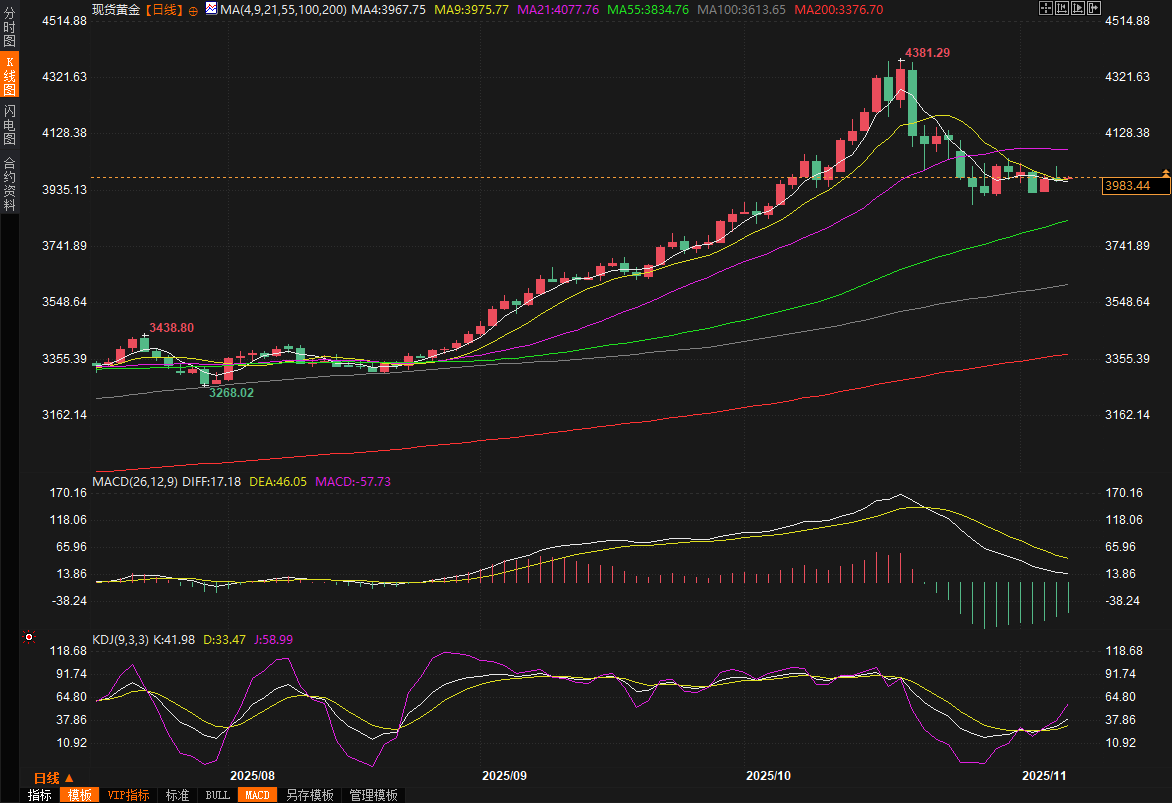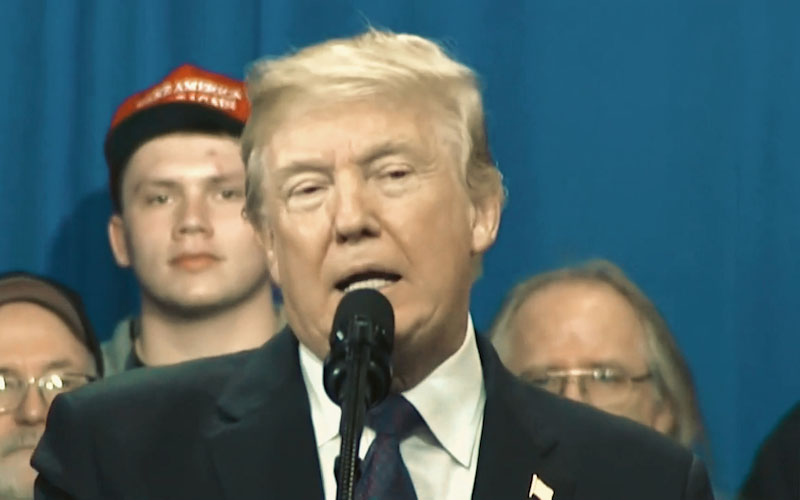Gold Trading Alert: Reversal! Amid the shutdown and tariff storm, gold prices surged to 4020 before falling back; is the year-end dream of 4400 shattered?
2025-11-07 07:36:12

A sudden storm of safe-haven demand erupts: government shutdown and tariff uncertainties ignite gold buying.
Gold, as a traditional safe-haven asset, often outperforms other assets during periods of heightened global uncertainty, and Thursday's Asian and European trading sessions provided a prime example. The US government shutdown has entered its 37th day, making it not only the longest shutdown in history but also a "data black hole" affecting the economic pulse. The official Bureau of Labor Statistics' monthly employment report has been frozen, forcing investors to rely on sporadic information from private channels, further amplifying market panic.
Meanwhile, the U.S. Supreme Court sharply questioned the legality of President Trump's use of the National Emergency Act to impose comprehensive tariffs, leaving a potential "tariff black swan" event unresolved. Trade Representative Greer publicly stated that if the Supreme Court rules the tariffs invalid, the Treasury Department will face a wave of refunds, and Trump himself has hinted at initiating a "second option," which is tantamount to adding fuel to the global trade war.
Against this backdrop, safe-haven demand has surged toward gold. Peter Grant, Vice President and Senior Metals Strategist at Zaner Metals, noted, "With the US government shutdown and Supreme Court justices expressing skepticism about the legality of Trump's across-the-board tariffs, we are seeing a resurgence in safe-haven buying."
This sentiment is not only reflected in institutional investors' position adjustments but also in retail investors' anxieties about the economic outlook. Imagine, when the political situation in Washington is in complete chaos, how can ordinary investors not turn their attention to that "eternal safe-haven glow"? It is these factors combined that propelled gold prices to a strong rebound during Thursday's Asian and European sessions, briefly breaking through the psychological barrier of $4,000, demonstrating gold's resilience in turbulent times.
The dollar's weakness was exposed: weak labor market data became the final straw that broke the camel's back.
The seesaw relationship between gold prices and the US dollar index has a long history. This Thursday, the dollar fell 0.44% from a four-month high, directly opening the door for overseas gold buyers and making this precious metal "good value for money" for international investors.
The Challenger, Gray & Christmas report shattered market illusions about a US economic recovery: in October, US employers announced 153,074 layoffs, a surge of 183% year-on-year, marking the largest single-month figure in 22 years. Companies are drastically cutting costs and embracing AI-driven change, leading to the evaporation of jobs in sectors such as technology and finance. This is not merely a cold accumulation of numbers, but a prelude to a labor market "winter."
Convera's FX and macro strategist, Antonio Ruggiero, further explained: "Due to the lack of data caused by the government shutdown, investors' optimism about the US economy has been exaggerated. When data like the Challenger layoff report comes out, it can easily trigger panic among investors because they still don't believe in the sustainability of the improved dollar sentiment. This is enough to trigger position liquidation, leading to a weaker dollar."
Under the dual pressure of the 200-day moving average, the US dollar index fell below the 100 mark, recording its worst performance in nearly four weeks. This weakness in the dollar not only boosted the relative attractiveness of gold but also indirectly amplified expectations for further easing policies from the Federal Reserve.
The Chicago Fed's estimates suggest that the U.S. unemployment rate may climb to 4.4% in October, a four-year high. This has given a boost to gold bulls and shifted previously wavering market sentiment toward a more favorable outlook.
Rising expectations of a Fed rate cut: a 70% probability in December still supports gold prices.
The Federal Reserve's policy moves have always been a "bellwether" for the gold market. After the Fed cut interest rates for the second time this year last week, market bets on further easing in December have intensified again.
According to the CME FedWatch tool, traders on Thursday raised their probability of a 25-basis-point rate cut in December to 70%, a slight jump from 62% the previous day.
Jim Baird, chief investment officer at Plante Moran Financial Advisors, commented on the Challenger employment data, saying, "Given that the job market has been slightly subdued since May, if this is an indication of the recent trend, then it is a warning to the market."
This warning not only pushed down U.S. Treasury yields—the 10-year yield fell to 4.089% and the 30-year yield fell to 4.686%—but also added a catalyst for monetary easing to the safe-haven narrative of gold.
Historically, gold has often seen a "golden harvest" whenever the Federal Reserve turns dovish. The current shutdown has amplified economic uncertainty, and while Fed Chairman Powell has left room for maneuver in his recent speeches, the market has already begun to repric the December agenda.
Michael Green, chief strategist at Simplify Asset Management, bluntly stated, "The Challenger layoff report is disappointing, suggesting that the pace and extent of weakness in the labor market appear to be exceeding the Fed's expectations."
With these expectations in mind, bullish momentum in gold is quietly building, and while traders remain cautious, they have already begun positioning themselves for the year-end market. Peter Grant's optimistic prediction—a year-end target of $4,300 to $4,400 per ounce for gold—is not mere speculation, but a rational deduction based on the Federal Reserve's easing path.
US stocks are shrouded in gloom: the tech stock crash has diminished gold's safe-haven appeal.
Despite initial safe-haven demand dominating the market, the decline in gold prices during the New York session exposed the "collateral damage" of the sharp drop in US stocks. The Dow Jones Industrial Average fell 0.84% to 46,913.65 points, the S&P 500 declined 1.12% to 6,720.38 points, and the Nasdaq Composite plunged even more sharply, falling 1.90% to 23,053.99 points. In particular, the collective plunge in artificial intelligence-related stocks caused the Philadelphia Semiconductor Index to plummet by 2.4%.
Paul Nolte, senior wealth advisor at Murphy & Sylvest, points out: “Valuation remains a concern in the long term, but the market is still biased towards bullishness. Earlier this week we saw a 1% to 1.5% pullback, and what happened the next day? We rose another 80 basis points. So that ‘buy the dip’ mentality still exists.” However, with the government shutdown continuing and economic data in the vacuum, this “buy the dip” mentality is showing signs of fatigue.
DoorDash's disappointing quarterly revenue further fueled the fire, pushing the consumer discretionary sector down 2.5%. Investors are uneasy not only because of the valuation bubble in tech stocks, but also because of the combined concerns about Trump's trade policies and the risk of a shutdown.
According to data from Revelio Labs, the U.S. economy lost a net 9,100 jobs last month, with the government sector contributing the most, which further eroded risk appetite.
The broad-based correction in US stocks led to a surge in investor demand for cash, and while gold enjoys its safe-haven appeal, it couldn't escape the downturn, ultimately being forced to "fall with the tide" in the closing minutes. This phenomenon reminds us that gold is not an isolated entity; its movements are often driven by sentiment in the equity market, and short-term corrections are inevitable during periods of peak uncertainty.
summary
In conclusion, Thursday's surge and subsequent decline in gold prices reflected a tug-of-war between safe-haven demand and risk aversion. The protracted US government shutdown, the legal battle over the legality of tariffs, the stark contrast in the labor market, and the growing expectation of a Fed rate cut all provided structural support for gold, but these could not withstand the immediate impact of the US stock market crash.
Looking ahead, with the potential for a turnaround in the government shutdown and the Supreme Court's tariff ruling settling down, gold's safe-haven appeal may be revitalized. Peter Grant's $4300-$4400 target is not out of reach, and if the Federal Reserve cuts interest rates as expected in December, gold could end the year on a strong note. Investors should remain vigilant, monitoring the developments in private economic data, speeches by Federal Reserve officials, news related to the US government shutdown, and international geopolitical developments.

(Spot gold daily chart, source: FX678)
At 07:33 Beijing time, spot gold was trading at $3983.21 per ounce.
- Risk Warning and Disclaimer
- The market involves risk, and trading may not be suitable for all investors. This article is for reference only and does not constitute personal investment advice, nor does it take into account certain users’ specific investment objectives, financial situation, or other needs. Any investment decisions made based on this information are at your own risk.





















